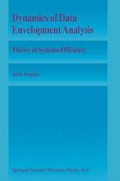Abstract
Technical change plays a central role in dynamic economics. Economic theory considers technology as the main driving force behind economic growth of capitalist economies. From an economic viewpoint three aspects of technical change have been discussed as important in the current economic literature. Technological progress embodied in labor and capital inputs, or disembodied in a time-varying form has focused on the effects of technology in improving factor productivity over time. Optimal rules of switching from one technique to another so that the economies of scale can be exploited over time have been widely investigated in modern theories of economic growth. At the microeconomic level the specification of technological diffusion and the way it affects the dynamic production process have provided an active field of modern research. One major implication of this research has been to modify the production frontier parameters, so that the impact of technological substitution and updating can be incorporated. Finally, the multi-stage aspects of the production process and the need for flexibility rather than fine tuning have been evidenced in the modern technology-intensive industries. The whole new field of flexible manufacturing systems, which is discussed in some detail in Chapter Five deals with these multi-stage aspects of the production process.
Access this chapter
Tax calculation will be finalised at checkout
Purchases are for personal use only
Preview
Unable to display preview. Download preview PDF.
References
Arrow, K.J. (1962), The Economic Implications of Learning by Doing,” Review of Economic Studies, Vol. 29, pp. 155–173.
Bellman, R. (1957), Dynamic Programming, Princeton: Princeton University Press.
Berndt, E.R. and C.J. Morrison (1981), “Capacity Utilization Measures: Underlying Economic Theory and an Alternative Approach,” American Economic Review, Vol. 71, pp. 48–52.
Broemeling, L.D. and H. Tsurumi (1987), Econometrics and Structural Change, New York: Marcel Dekker.
Compton, W.D., Dunlap, M.D. and J.A. Heim (1992), “Improving Quality Through the Concept of Learning Curves,” in Manufacturing Systems, Washington, D.C.: National Academy Press.
Enos, J.L. and W.H. Park (1988), The Adoption and Diffusion of Imported Technology, London: Croom Helm Publishers.
Farrell, M.J. (1957), “The Measurement of Productive Efficiency,” Journal off Royal Statistical Society, Series A, Vol. 120, pp. 253–290.
Hall, R.E. (1988), “The Relation Between Price and Marginal Cost,” Journal of Political Economy, Vol. 96, pp. 922–947.
Hall, R.E. (1990), “Invariance Properties of Solow’s Productivity Residual,” in Growth, Productivity and Unemployment, Cambridge: MIT Press.
Johansen, L. (1972), Production Functions, Amsterdam: North Holland.
Linstone, H.A. and D. Sahal (1976), Technological Substitution: Forecasting Techniques and Applications, New York: Elsevier Publishing.
Lucas, R.E. (1993), “Making a Miracle,” Econometrica, Vol. 61, pp. 251–272.
Mansfield, E. (1961), “Technical Change and the Rate of Imitation,” Econometrica, Vol. 29, pp. 741–766.
Modigliani, F. and F.E. Hohn (1955), “Production Planning Over Time and the Nature of Expectation and Planning Horizon,” Econometrica, Vol. 23, pp 46–66.
Moene, K.O. (1985), “Fluctuations and Factor Proportions: Putty-Clay Investments Under Uncertainty,” in Production, Multisectoral Growth and Planning, Amsterdam: North Holland.
Nielsen, M.B. and P. Fiehn (1976), “The Diffusion of New Technology in the U.S. Petroleum Refining Industry,” in Technological Substitution: Forecasting Techniques and Applications, New York: Elsevier Publishing.
Norsworthy, J.R. and S.L. Jang (1992), Empirical Measurement and Analysis of Productivity and Technological Change, Amsterdam: North Holland.
Panzar, J.C. and R.D. Willig (1981), “Economies of Scope,” American Economic Review, Vol. 72, pp. 268–272.
Romer, P.M. (1986), “Increasing Returns and Long Run Growth,” Journal of Political Economy, Vol. 94, pp. 1002–1037.
Romer, P.M. (1990), “Are Noncovexities Important for Understanding Growth,” American Economic Review, Vol. 80, pp. 97–103.
Seierstad, A. (1985), “Properties of Production and Profit Functions Arising from the Aggregation of a Capacity Distribution of Microunits,” in Production, Multi-sectoral Growth and Planning, Amsterdam: North Holland.
Sengupta, J.K. (1989), Efficiency Analysis by Production Frontiers: The Nonparametric Approach, Dordrecht: Kluwer Academic Publishers.
Sengupta, J.K. (1992), “Adjustment Costs and the Production Frontier Analysis,” Economic Notes, Vol. 21, pp. 316–329.
Sengupta, J.K. (1993), “Growth in NICs in Asia: Some Tests of New Growth Theory,” Journal of Development Studies, Vol. 29, pp. 342–357.
Sengupta, J.K. (1994), “Empirical Tests of New Growth Theory: Openness and Growth,” Journal of Economic Integration, Vol. 9, pp. 393–415.
Sengupta, J.K. and B.Q. Lin (1993), “Recent Rural Growth in China: The Performance of the Rural Small Scale Enterprises (198086),” International Review of Applied Economics, Vol. 7, pp. 177–196.
Sengupta, J.K. (1995), “Estimating Efficiency by Cost Frontiers: A Comparison of Parametric and Nonparametric Methods,” forthcoming in Applied Economics Letters.
Shen, T.Y. (1965), “Economies of Scale, Expansion Path and Growth of Plants,” Review of Economics and Statistics, Vol. 47, pp. 420–428.
Solow, R.M. (1957), “Technical Change and the Aggregate Production Function,” Review of Economics and Statistics, Vol. 39, pp. 312–320.
Author information
Authors and Affiliations
Rights and permissions
Copyright information
© 1995 Springer Science+Business Media Dordrecht
About this chapter
Cite this chapter
Sengupta, J.K. (1995). Technical Change and Efficiency. In: Dynamics of Data Envelopment Analysis. Springer, Dordrecht. https://doi.org/10.1007/978-94-015-8506-4_3
Download citation
DOI: https://doi.org/10.1007/978-94-015-8506-4_3
Publisher Name: Springer, Dordrecht
Print ISBN: 978-90-481-4582-9
Online ISBN: 978-94-015-8506-4
eBook Packages: Springer Book Archive

